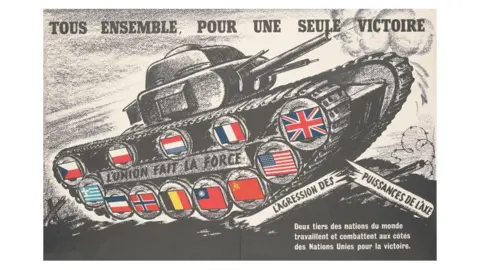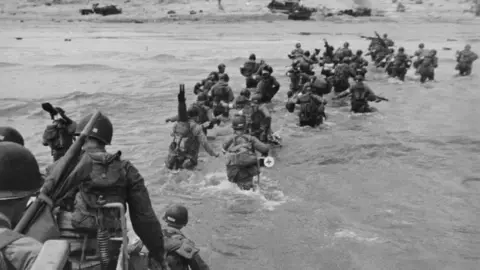D-Day: 10 things you might not know about the Normandy invasion
 IWM
IWMOn 6 June 1944, British, US and Canadian forces invaded the coast of Normandy in northern France.
The landings were the first stage of Operation Overlord - the invasion of Nazi-occupied Europe - and aimed to bring an end to World War Two.
By night-time, around 156,000 Allied troops had arrived in Normandy, despite challenging weather and fierce German defences.
At the end of D-Day, the Allies had established a foothold in France and within 11 months Nazi Germany was defeated.
Here are 10 things you may not have known about the operation:
1. Photography appeal
As early as 1942, the BBC launched a bogus appeal for photographs and postcards from the coast of Europe, from Norway to the Pyrenees.
It was actually a way of gathering intelligence on suitable landing beaches and Normandy was settled on.
Millions of photos ended up being sent to the War Office and, with the help of the French Resistance and air reconnaissance, military bosses were able to target the best landing spots for D-Day.
 Getty Images
Getty Images2. Phantom army
The Allies put a lot of effort into trying to convince the Germans that the invasion was going to be near Calais, not Normandy.
They invented phantom field armies based in Kent as part of their D-Day deception plan, named Operation Fortitude.
They built dummy equipment - including inflatable tanks - parachuted dummies, used double agents and released controlled leaks of misinformation which led the Germans to believe the Allies were going to invade via the Pas-de-Calais and Norway.
The Germans took the bait so much that even after D-Day they held many of their best troops in the Calais area expecting a second invasion.
3. Two million troops
By 1944 more than two million troops from more than 12 countries were in Britain preparing for the invasion.
On D-Day, Allied forces consisted primarily of US, British and Canadian troops but also included Australian, Belgian, Czech, Dutch, French, Greek, New Zealand, Norwegian, Rhodesian [present-day Zimbabwe] and Polish naval, air and ground support.
 IWM
IWM4. Weather watching
The officers organising the operation were very particular about the timing of D-Day.
They wanted a full moon with a spring tide so they could land at dawn when the tide was about half way in - but those kind of conditions meant there were only a few days that could work.
They chose to invade on 5 June, but ended up delaying by 24 hours because of bad weather.
It was Group Captain James Martin Stagg who persuaded General Eisenhower to change the date.
5. Rommel's shoes
In fact, the forecast was so bad that the German commander in Normandy, Erwin Rommel, felt so sure there wouldn't be an invasion he went home to give his wife a pair of shoes for her 50th birthday.
He was in Germany when the news came of the invasion.
6. Sleeping Hitler
When the D-Day forces landed, Nazi leader Adolf Hitler was asleep.
None of his generals dared order reinforcements without his permission, and no-one dared wake him.
Crucial hours were lost in the battle to hold Normandy.
When Hitler did finally wake up, at around 10am, he was excited at news of the invasion - he thought Germany would easily defeat the Allies.
7. Commonwealth strength
While America formed the biggest national contingent, the combined force of Commonwealth service personnel - mostly British and Canadian - was greater.
Of the 156,000 men who landed in France on 6 June, 73,000 were American, and 83,000 British or Canadian. The Commonwealth naval contingent was twice that of the Americans.
8. Bloody Omaha
There were five beaches that were chosen for the operation, codenamed, from east to west, Sword, Juno, Gold, Omaha, Utah.
Casualties varied widely - on "Bloody Omaha", where around 4,000 men were killed or wounded, one US unit landing in the first wave lost 90% of its men.
On Gold Beach, by contrast, casualty rates were around 80% lower.
 IWM
IWMThe fighting during the Battle of Normandy, which followed D-Day, was as bloody as it had been in the trenches of World War One.
Casualty rates were slightly higher than they were during a typical day during the Battle of the Somme in 1916.
9. Smashed toilets
The vibration of HMS Belfast's guns firing during D-Day was so powerful it actually cracked the crew's toilets.
10. Pub test
Having been given his top-secret mission to attack the Merville battery on D-Day, Terence Otway had to be certain his men wouldn't spill the beans ahead of 6 June 1944.
He sent 30 of the prettiest members of the Women's Auxiliary Air Force, dressed in civilian clothes, into village pubs near where his soldiers were training.
They were asked to do all they could to discover the men's mission. None of the men gave anything away.
Sources: The Imperial War Museum, BBC iWonder, BBC D-Day.
